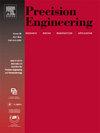基于机器学习的TC4薄壁合金高速微铣削颤振识别音频信号特征评估
IF 3.7
2区 工程技术
Q2 ENGINEERING, MANUFACTURING
Precision Engineering-Journal of the International Societies for Precision Engineering and Nanotechnology
Pub Date : 2025-04-12
DOI:10.1016/j.precisioneng.2025.04.011
引用次数: 0
摘要
本工作确定了在薄壁TC4结构高速微铣削过程中检测颤振发生所必需的音频信号特征。这些特征是从信号的短时间傅里叶变换中得到的,以捕捉微铣削过程的低幅度振动。在三种不同的径向切割深度和四种不同的传声器倾斜角度下进行径向微铣削实验,结果表明60°的倾斜角度为最佳倾斜角度。在主成分分析的基础上,找到了熵、峰度和形状因子为最优特征。发现径向基函数是最适合的核函数,对所有切削条件的预测精度最高,达到98%。利用最优特征和核在支持向量机中将加工条件划分为稳定区和颤振区。使用加工表面验证了颤振痕迹的存在。本文章由计算机程序翻译,如有差异,请以英文原文为准。
Machine learning based assessment of audio signal features for chatter identification in high-speed micromilling of thin-walled TC4 alloy
The present work identifies the audio signal features that are necessary to detect the chatter onset during high speed micromilling of thin-walled TC4 structure. These features have been derived from the short time Fourier transform of the signal to capture the low magnitude vibration of the micromilling process. Radial micromilling experiments at three different radial depths of cut and four different microphone tilt-angles shows 60° tilt angle as the optimum tilt angle. Entropy, kurtosis and shape factor have been found to be the optimum features based on the principal component analysis. Radial Basis Function has been found to be best suitable kernel with the highest prediction accuracy of 98 % for all the cutting conditions. The optimum features and kernel have been used in support vector machine (SVM) for classification of machining conditions into stable and chatter dominant zone. The presence of chatter marks has been validated using the machined surfaces.
求助全文
通过发布文献求助,成功后即可免费获取论文全文。
去求助
来源期刊
CiteScore
7.40
自引率
5.60%
发文量
177
审稿时长
46 days
期刊介绍:
Precision Engineering - Journal of the International Societies for Precision Engineering and Nanotechnology is devoted to the multidisciplinary study and practice of high accuracy engineering, metrology, and manufacturing. The journal takes an integrated approach to all subjects related to research, design, manufacture, performance validation, and application of high precision machines, instruments, and components, including fundamental and applied research and development in manufacturing processes, fabrication technology, and advanced measurement science. The scope includes precision-engineered systems and supporting metrology over the full range of length scales, from atom-based nanotechnology and advanced lithographic technology to large-scale systems, including optical and radio telescopes and macrometrology.

 求助内容:
求助内容: 应助结果提醒方式:
应助结果提醒方式:


